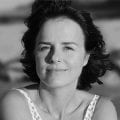

As a little girl, when there was tension in the home, Tina Stromsted would slip out the house into the field next door, and dance. As she twirled and swooped and breathed in the rhythms of Nature, she was able to release her anxiety to the winds, and ground herself enough to straighten her small back, and return to her family. Little did she know that this instinctual act of refuge – her own homecoming to self – would become her life-calling.
Of Norwegian descent, Tina was not raised with plastic Barbie dolls and their trendy outfits. She grew up with trolls – magic spirits who lived under bridges. So the Jungian concept of shadow, of a powerful life force lurking beneath the surface, was one that came easily to her. Today, as a Jungian analyst and Somatic psychotherapist, she has integrated dance and movement therapy into her four decades of clinical experience.
I wanted to speak to Tina about her latest course for Jung Platform. It explores how we can come home to our bodies and experience it as our soul friend as we open a vital connection between body, psyche, and spirit. It also touches on how we can awaken and increase body awareness by getting to know the languages of the body, which express not only our history, challenges, and dilemmas, but are also a source of wisdom. She explores how Jung discovered Active Imagination, and how we can engage it in embodied ways to integrate vital learnings into everyday life. And she looks at how dreams, images, symbols, and body symptoms can be used as starting points for embodied exploration, as we gently engage the practice of Active Imagination in movement.
The more I researched Tina’s work, the more questions I had about embodiment, a concept that (ironically) I seemed to understand only cerebrally. They flew in from the myriad corners of my mind, in a rather formless and blurred way, looking for Tina. For clarity. For direction. And for earthing. Here are some of them:
How does one learn kinesthetically?
Learning through doing, with your body, is kinesthetic. Take teaching somebody to ride a bike, for example. You can say, so here’s the bike and you put your leg over it, and you have to balance etc. Or you might show them a picture of the bicycle. But it isn’t until you lift them up and put them on the bicycle that they get the feel of it and learn to ride into life on their own.
What about asking a student to imagine a concept using the senses? Is that not cerebral, asking them to imagine something with their mind, rather than doing it?
Yes, but Imagining is part of learning. The coaches of many top athletes – be it basketball, shot put or dancing – ask their players to imagine getting it in the hoop, throwing the shot, feeling the dance step. Or players or dancers are shown what the movement or dance step is like, which gets the mirror neurons in the brain firing. The dancer thinks, Oh I know what it feels like to do that dance movement. Einstein comes to mind when he said, “What you can’t imagine, you can’t discover”. So yes, we engage the imagination in embodied depth work.
Does that mean Imagining involves the body, as well as the mind?
It does. A friend of mine who is a Jungian analyst whose work is deeply informed by neuroscience once told me that the one thing that fires both sides of the brain is… poetry. Metaphor. Because you have the verbal left brain and the emotional image-making right brain working together. And that’s part of the healing power of metaphor. An image creates a feeling, and that has emotional impact in the body.
So how does one process unbearable pain using the body?
Slowly, respectfully, safely. Because the body is storing the trauma and the pain, putting it on ice till you feel strong and safe enough to bear it, to begin to thaw, to begin to feel what got frozen in time, what may have kept you back at that developmental stage of your life. Some bright, otherwise successful adults have an emotional six-year old inside, who can’t get along in relationships for instance. From a Jungian perspective, these are inner figures who are living at different levels of development inside, where development got stuck, frozen, or wounded. They also appear in our dreams as children or wounded souls, so working with dreams or dream figures in the body is one way to work with that.
Would you consider the body to be a more reliable, authentic witness than the brain?
We need integration between the brain, the heart, and the gut – each has their own wisdom. That said, most psychotherapists privilege words or talk therapy. The body has been the stepchild for a very long time, and work in the body has been marginalized. More recently therapists have been trying to bring the body into the therapeutic space. With the evolution of neuroscience, attachment theory, trauma work and other Somatic practices people have come to realize that our feelings are stored in the body and that integrating embodied elements in psychotherapy can be profoundly integrative and healing.
What about reading – is reading simply escape, or can it be an embodied experience?
We learn so much from other people’s lives and stories, what they felt and went through, and how they handled it. Part of what saved my life as a child was reading myths and fairytales. These include the archetypal characters, but I believe that the great writers of today hit the archetypal dimension all the time. So yes, there is an element of escape, but also nourishment of body to body, mind to mind, life to life.
Why are we nicer after yoga?
Yoga helps open up the breath and unite the whole body. It helps titrate the nervous system. From the perspective of trauma therapy and neuroscience, when we’re worked up and anxious that state can keep accelerating. But if we do something intentionally to change our state, to get more grounded – like yoga which regulates and balances the sympathetic and parasympathetic nervous systems – we have some resources to take back to our stress. We’re more dropped into our bellies, more feet on the earth, more connected to the environment.
I believe Jung did yoga not only for his physical well-being, but to calm himself down after his break with Freud. To get more grounded and emotionally regulated, and to help him process the upwelling of spontaneous energies and images he was experiencing. Yoga provided a developmental system of the evolution of higher consciousness that he felt was necessary for the further development of Western psychology. A profoundly integrative body/mind/spirit practice, it also enriched his understanding of the individuation process. Yoga deepens the breath and circulates chi/life energy throughout the body. It helps our mood, opens our consciousness, and offers a pathway to sensing our spiritual home in the body. And as you said, it makes us nicer!
Why does a walk in Nature do us so much good? What’s actually going on?
You’re finding a resonance between your body and the planetary body. It’s attunement, like a violin, to the spirit in Nature. When you take your forest bath in the woods, I’m imagining your breath becomes more attuned, your feet are on the good earth, your body on the earth’s body. You’re opening up to fuller oxygenation with the breath of the planet. This also helps open up the cellular intelligence of the body and gives us more access to the creative imagination – to the breath, to vitality, to the intelligence in the cells. And that’s when we start to create. That’s the next step in Jung’s “active imagination” approach, the creative process. I once heard that Marie-Louise Von Franz said she’d never known a problem that couldn’t be solved by a walk. And I have never found a problem that couldn’t be solved by a tree.
I love Tina’s understanding that we touch the DNA of the earth with every step in Nature. (I recently heard someone describe geology as the biography of the earth.) And that this was something she knew instinctively as a child, with her body, as she danced her stress away in Rumi’s field next door. I look forward to learning even more from her in her course Coming Home to the Body. I hope you will join me.
Explore how you can foster a feeling of safety, resilience, and ease through bodily experience, natural movement, and creative arts. Tina Stromsted’s course Coming Home to the Body offers case examples and practical tools to help you reconnect with your deeper inner resources.

Susan Mann
Educational Development ManagerSusan is a writer and a teacher. Her interest in depth psychology comes from a love for mythology, dreams and the imagination, as well as a fascination for the creative possibilities that exist within the shadow.
More Posts by Susan Mann